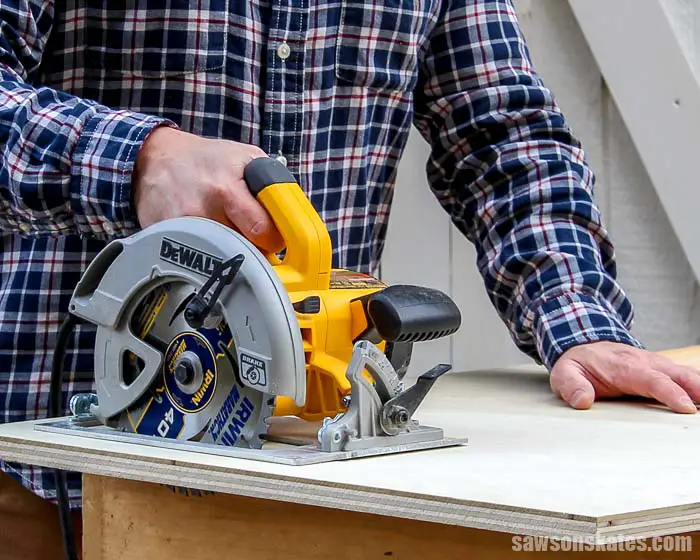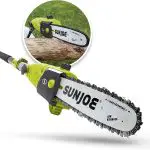When using a circular saw, be sure to cut on the waste side of the cut mark to allow for the blade’s kerf. This ensures an accurate and clean cut on the desired material.
Proper cutting technique is crucial for achieving precise and efficient results with a circular saw. When cutting, always position the material so that the waste part falls off the edge, preventing any damage or misalignment caused by the saw’s blade.
By following this guideline, you can ensure a smooth cutting process and achieve the desired outcome with your circular saw. Remember to prioritize safety and accuracy when working with power tools such as a circular saw.
1. Choosing The Right Blade
Choosing the right blade for your circular saw is crucial to ensure a clean and accurate cut. Different blade types serve various purposes, so understanding their uses is essential. When selecting a blade, consider factors such as the type of material you are cutting and the desired outcome.
For example, a fine-tooth blade is ideal for cutting plywood, while a carbide-tipped blade is suitable for cutting through solid wood. Additionally, there are specialty blades available for cutting metals, plastics, and other materials. By using the appropriate blade, you can minimize splintering and achieve professional-looking results.
Always remember to cut on the waste side of the marked line to allow for the blade’s kerf, which refers to the width of the cut made by the blade. Following these guidelines will ensure that your cuts are precise and clean when using a circular saw.

Credit: www.amazon.com
2. Ensuring Proper Safety Measures
Ensuring Proper Safety Measures When using a circular saw, it is of utmost importance to wear protective gear. This includes safety goggles to protect your eyes from flying debris, earplugs to shield your ears from loud noise, and gloves to protect your hands.
Additionally, wearing a dust mask is crucial to prevent inhaling sawdust and other airborne particles. It is also important to set up a safe working environment. Clear the area of any clutter or obstacles that may pose a tripping hazard.
Make sure the workspace is well-lit and that the saw is placed on a stable work surface. Never operate a circular saw if you are tired or under the influence of drugs or alcohol. Always maintain a firm grip on the saw and keep your fingers away from the cutting line.
By following these safety measures, you can ensure a safe and productive experience when using a circular saw.
3. Marking The Cut Line Accurately
To accurately mark the cut line when using a circular saw, there are a few techniques you can employ. Firstly, it’s essential to use measurement tools, such as a tape measure or ruler, to ensure accuracy. Take precise measurements and mark the cut line accordingly.
Secondly, consider using a square or angle guide to create a perfectly straight line. These guides can be clamped onto the material and used as a reference for marking the cut line. Additionally, you may want to consider using a pencil or marker with a fine tip to make thin, precise markings.
This will ensure that your cut line is clear and easy to follow. By following these techniques for marking the cut line accurately, you can ensure clean and precise cuts when using a circular saw.
4. Setting The Correct Cutting Depth
To ensure safe and accurate cuts when using a circular saw, it is essential to set the correct cutting depth. This can be achieved by adjusting the saw’s cutting depth to match the desired cut. By doing so, you can avoid excessive cutting depth, which not only leads to wastage of materials but also increases the risk of accidents.
Maintaining the appropriate cutting depth allows for precise and clean cuts without compromising on safety. Always remember to cut on the waste side of the cut mark, providing enough allowance for the blade’s kerf. Following these guidelines will help you make efficient and accurate cuts while using a circular saw.
5. Maintaining A Steady Grip
To maintain a steady grip while using a circular saw, proper hand placement and grip techniques are crucial. By placing your hands in the correct position and using the right techniques, you can enhance stability and control during the cutting process.
It’s important to hold the saw with a firm grip, ensuring that your fingers are away from the path of the blade. Additionally, make sure to maintain a balanced stance and use both hands to control the saw. This will help you guide the saw smoothly and prevent any accidental slips or jerks.
By following these guidelines, you can ensure safer and more accurate cuts with a circular saw.
6. Applying Smooth And Controlled Cutting Motion
When using a circular saw, it is important to apply a smooth and controlled cutting motion. This will ensure accurate and clean cuts. To achieve this, you should avoid jerky or rushed movements. Maintaining a steady pace and keeping your hands steady will help you guide the saw smoothly along the desired cutting line.
Additionally, it is important to position yourself properly and have a firm grip on the saw to maintain control throughout the cutting process. By following these techniques for smooth and controlled cuts, you can achieve precise and professional results with your circular saw.
7. Utilizing Auxiliary Cutting Aids
Utilizing auxiliary cutting aids such as guides, clamps, or jigs when using a circular saw brings numerous benefits. These tools enhance accuracy and provide added precision to your cuts. Guides help in maintaining a straight cutting line, ensuring consistency throughout the piece.
Clamps securely hold the material in place, preventing it from shifting or vibrating during the cutting process. This stability leads to cleaner and more accurate cuts. Jigs, on the other hand, allow for repetitive cuts with consistent dimensions, perfect for projects that require multiple identical pieces.
Whether you are a professional carpenter or a DIY enthusiast, incorporating these additional tools into your circular saw workflow can significantly improve your cutting results and save you time and effort. So, next time you’re reaching for your circular saw, remember the benefits of using guides, clamps, or jigs for added precision.
8. Understanding Common Mistakes And How To Avoid Them
Understanding Common Mistakes and How to Avoid Them When using a circular saw, it is important to be aware of common errors that may occur during the cutting process. One common mistake is not cutting on the waste side of the cut mark, which can result in a misalignment of the final cut.
To prevent this, always ensure that the blade is positioned correctly and cut slightly on the waste side of the line. Additionally, not using a proper guide or fence can lead to inaccurate cuts. It is crucial to use a guide or fence to maintain proper alignment and achieve precision cuts.
Another mistake is not adjusting the depth of the cut properly, resulting in cuts that are either too shallow or too deep. Always double-check the depth settings before making a cut. Lastly, not wearing appropriate safety gear, such as safety glasses and ear protection, can put you at risk of injury.
Always prioritize safety and wear the necessary protective equipment when using a circular saw. By being aware of these common mistakes and implementing the necessary precautions, you can achieve accurate and precise cuts with a circular saw.
Frequently Asked Questions On When Using A Circular Saw Be Sure To Cut?
What Is The Most Important Maintenance On A Circular Saw Involves The __________?
When using a circular saw, the most important maintenance involves cutting on the waste side of the cut mark to allow for the blade’s kerf.
What Saws With Fine Blades That Are Excellent For Delicate And Intricate Cutting Are Called?
Saws with fine blades that are excellent for delicate and intricate cutting are called precision saws.
Will Most Hammer Drills Not Hammer Until Pressure Is?
Most hammer drills will not hammer until pressure is applied.
When Changing Bits And Blades What Should You Do First With The Power Tool?
Before changing bits and blades on a power tool, make sure to follow these steps: 1. Turn off the power tool and unplug it from the power source. 2. Release any safety locks or mechanisms on the tool. 3. Carefully remove the old bit or blade by following the manufacturer’s instructions.
4. Install the new bit or blade securely, ensuring it is properly aligned and tightened. Remember to always prioritize safety when working with power tools.
Conclusion
When using a circular saw, it is crucial to follow proper techniques and practices to ensure safety and accuracy in your cuts. One of the key considerations is to cut on the waste side of the cut mark, allowing for the blade’s kerf.
This approach helps prevent any damage to your desired piece and ensures a clean, precise cut. Additionally, if you want identical cuts for multiple pieces, a technique called gang cutting can be employed. By clamping the pieces together and making a steady cut, you can achieve consistent lengths and accurate results, even with limited tools like a circular saw.
To minimize splintering, you can wrap the wood in masking or duct tape or clamp it between sacrificial pieces of wood, focusing on the top surface. By taking these precautions, you can significantly reduce tear-out and achieve smoother cuts. Always prioritize safety and precision when using a circular saw.
Following these guidelines will help you achieve the best results and protect yourself from potential accidents. Happy cutting!



















